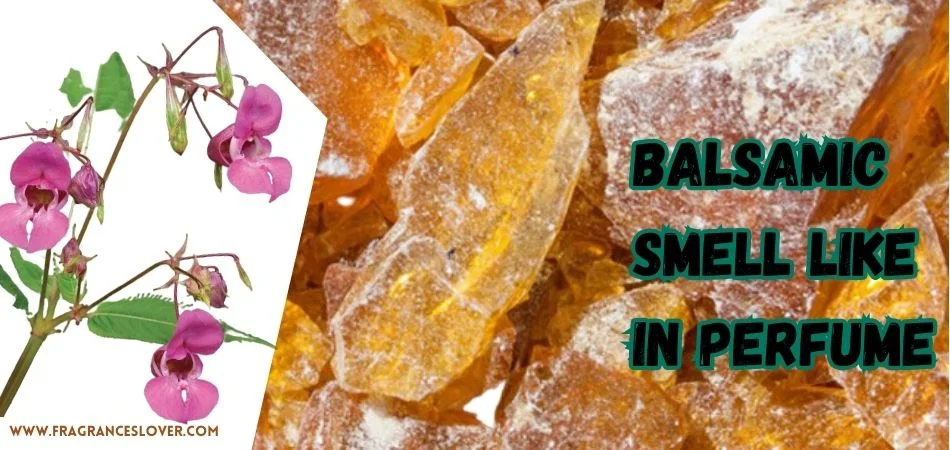The world of perfumery is vast and varied, with each scent carrying its unique story. Among the numerous notes that make up fragrances, balsamic notes are particularly intriguing. At its core, the balsamic scent in perfumes is a luxurious blend of warm, sweet, and resinous tones, often evoking a feeling of depth and sophistication. Before diving into its olfactory profile, let’s understand the origin and characteristics of balsamic notes.

Understanding Balsamic Notes:
Origin: Balsamic notes in perfumes are predominantly derived from aromatic resins of trees. The primary sources include benzoin, tolu, and storax trees. These resins have been used since ancient times, not just for their aromatic qualities but also for medicinal purposes.
General characteristics: When you experience a perfume with balsamic notes, the first impression is often a warm embrace of sweet and resinous aromas. There’s also a slightly woody tone, making it reminiscent of a cozy evening by the fireplace or a walk through a dense forest.
Comparison to the culinary balsamic vinegar: It’s essential to differentiate between balsamic notes in perfumes and the familiar balsamic vinegar found in kitchens. While they share the term “balsamic,” their scent profiles are distinct. Culinary balsamic vinegar, derived from grape must, has a sharp, tangy aroma, whereas the balsamic notes in perfumes are more about warmth, sweetness, and depth. They lack the acidic and vinegary quality of the culinary counterpart.

The Olfactory Profile of Balsamic Scents:
Sweet undertones: Balsamic scents are known for their soft and rich sweetness, which is neither overpowering nor cloying. There’s often a hint of vanilla, evoking a comforting and nostalgic feeling, much like freshly baked goods or a warm vanilla pudding.
Woody and smoky nuances: The balsamic profile is enriched with a subtle presence of woody and smoky notes. These nuances add depth, making the scent more enticing and layered. It’s like the gentle smokiness one would sense while burning aged wood, adding a dimension of mystery to the fragrance.
Resinous characteristics: A hallmark of balsamic notes is its resinous quality. This characteristic is reminiscent of amber, which is golden, warm, and enveloping. This amber-like quality makes balsamic scents perfect for creating a luxurious and opulent aura.
Earthy undertones: Last but not least, balsamic scents often carry earthy undertones, providing a grounding and calming effect. It’s like the smell of wet earth after a light drizzle – rejuvenating and soul-soothing.
Benefits of Balsamic Notes in Perfumery:
Longevity: One of the most appreciated benefits of balsamic notes is the longevity it offers to fragrances. These notes are often resinous and deep, allowing the perfume to adhere to the skin for an extended period, thus prolonging the scent’s life.
Depth: Balsamic tones offer a rich and profound base, acting as a counterpoint to the more fleeting, brighter top notes. This depth ensures that the fragrance has a multi-dimensional character, evolving beautifully as it wears on the skin.
Sillage: Sillage refers to the trail left by a fragrance – the scent that lingers in the air as someone moves. Balsamic notes, with their warm and luxurious nature, leave an alluring and memorable sillage that can captivate those around the wearer.
Layering: When blended with other notes, balsamic elements can elevate the complexity and richness of a fragrance. It acts as a bridge, harmonizing disparate notes and ensuring the perfume feels cohesive.
Popular Perfumes with Balsamic Notes:
Shalimar by Guerlain: A timeless classic, Shalimar is renowned for its sensual blend of balsamic undertones, enhanced with bergamot, vanilla, and other oriental notes. The balsamic quality provides a warm base that underscores the perfume’s romantic and opulent nature.
Opium by Yves Saint Laurent: This iconic fragrance boasts a pronounced balsamic character, enriched with spices and oriental notes. The balsamic depth in Opium creates a captivating aura, evoking the mysteries of the East.
Tom Ford’s Black Orchid: A modern masterpiece, Black Orchid is a heady mix of dark chocolates, black truffle, and fruits. Its balsamic elements provide a rich backdrop that accentuates the perfume’s seductive allure.
Midnight Poison by Dior: With its blend of roses, amber, and patchouli, this fragrance has a striking balsamic undertone that elevates its dark, fairy-tale-like charm.
Combining Balsamic with Other Notes:
Floral: Balsamic notes offer a robust and warming backdrop to the airy, fresh floral tones. Imagine walking in a garden during sunset; the fresh scent of blooming flowers complemented by the deepening warmth of the evening – that’s the effect of combining floral with balsamic notes.
Citrus: When paired with citrus, balsamic notes offer a delightful contrast. The freshness of lemon, orange, or grapefruit set against the deep warmth of balsamic creates a dynamic and refreshing scent profile, perfect for a modern, energetic fragrance.
Woody: Combining balsamic notes with woody elements like cedar, sandalwood, or oakmoss results in a forest-like ambiance. The synergy here is seamless, with both profiles echoing themes of depth, earthiness, and natural warmth.
Oriental: Oriental perfumes are known for their opulence and exotic character. Adding balsamic undertones can enhance this luxurious feel, making the scent feel even more lavish, mysterious, and inviting.
Recommendations for those New to Balsamic Scents:
Entry-level balsamic perfumes to try: For those who are dipping their toes into the realm of balsamic fragrances, consider starting with lighter blends where balsamic notes are harmoniously balanced with other elements. Some recommendations include:
- Bvlgari Man Glacial Essence: A woody balsamic fragrance that’s subtle yet captivating.
- Dolce & Gabbana The One: A gentle introduction to the world of balsamic scents, with its mix of tobacco, amber, and other notes.
- Estée Lauder Sensuous: A soft blend of woods, amber, honey, and molten woods, offering a gentle introduction to balsamic elements.
Tips on how to wear them and what occasions they’re suitable for: Balsamic fragrances, given their warm and deep nature, are perfect for evening events and cooler weather. However, lighter balsamic blends can be worn during daytime or in warmer climates without feeling overwhelming. It’s always a good idea to do a patch test before fully applying to ensure the scent compliments your body chemistry. For formal events or intimate gatherings, balsamic fragrances can create an aura of sophistication and allure.
Conclusion
Balsamic notes in perfumery are a testament to the art’s depth and diversity. Their unique profile – warm, resinous, and enveloping – offers a sensory experience that’s both comforting and luxurious.
They can transport you to ancient resin markets, cozy fireside evenings, or enchanted forests, depending on their blend. While they might not be the most talked-about notes in fragrances, their contribution is undeniably profound.
We encourage every fragrance enthusiast, whether a seasoned nose or a newbie, to explore and truly appreciate the magic that balsamic-infused fragrances bring to the table.
Related topics:


